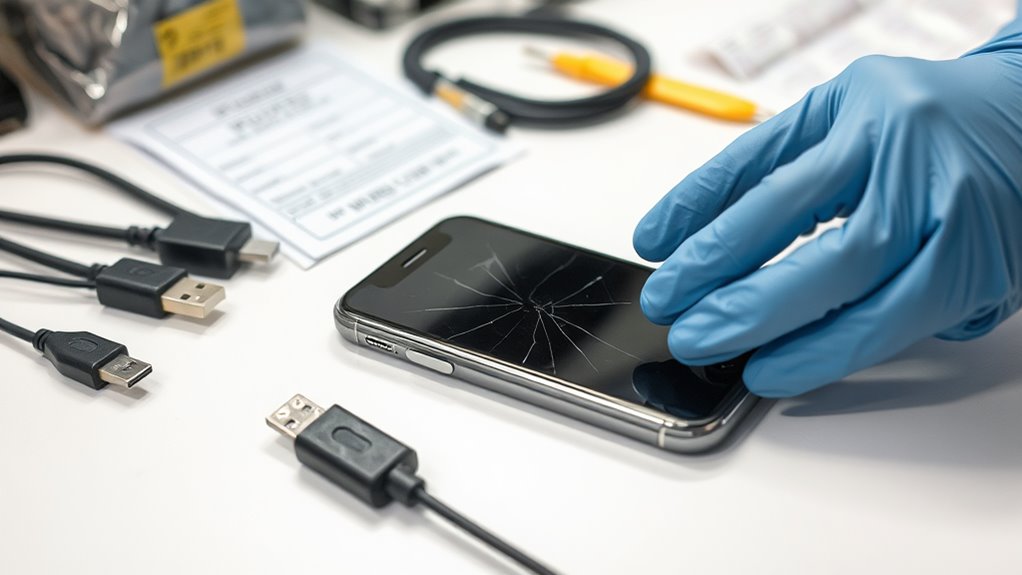A thorough digital evidence collection manual for forensic investigators outlines critical protocols for gathering and preserving digital evidence. It emphasizes the importance of securing devices and utilizing write-blockers to maintain data integrity. The manual also details methodologies for accessing cloud storage and emphasizes the significance of a well-documented chain of custody. By following these best practices and employing advanced tools, investigators can guarantee reliable findings. Further exploration reveals more intricate techniques and technologies integral to this process.
Key Takeaways
- Secure mobile devices by disabling wireless connections to prevent tampering and unauthorized access during evidence collection.
- Use write-blockers to maintain data integrity when capturing evidence from hard drives and other storage devices.
- Document every step of the evidence collection process meticulously to ensure transparency and accountability.
- Uphold the chain of custody by recording all individuals who handle the evidence along with relevant dates and times.
- Employ specialized forensic tools and software for efficient recovery and analysis of digital evidence across various platforms.
Understanding Digital Evidence

Digital evidence encompasses any data stored or transmitted in digital form that may be relevant to an investigation. In the domain of digital forensics, it is essential to categorize evidence types effectively. This includes data from hard drives, mobile devices, cloud storage, and network logs, each capable of revealing critical information. Digital artifacts such as emails, documents, and multimedia files can offer insights into user behavior and intentions. In addition, metadata associated with these files can provide context and timelines important for establishing a narrative. Understanding the diversity of digital evidence types allows forensic investigators to approach cases methodically, ensuring that all relevant data is identified, preserved, and analyzed, ultimately supporting the integrity and accuracy of the investigative process. Furthermore, the role of investigators is crucial in bridging the gap between technology and law enforcement efforts, enabling organizations to strengthen cybersecurity measures against threats.
Best Practices for Evidence Collection
When collecting digital evidence, it is essential to adhere to established best practices to confirm the integrity and reliability of the data. Forensic investigators should begin by securing mobile devices to prevent any tampering or remote access. This includes disabling wireless connections and employing write-blockers when necessary. When dealing with cloud storage, it is imperative to obtain proper authorization and utilize appropriate tools to capture data without altering it. Documentation should be meticulous, detailing every step taken during evidence collection. Chain of custody must be maintained to confirm accountability. Additionally, investigators should create bit-for-bit images of devices and store copies securely, confirming that original evidence remains untouched. By following these practices, the validity of digital evidence can be preserved for legal scrutiny, ensuring adherence to legal standards and ethical considerations throughout the investigation process.
Tools and Technologies for Forensic Investigators
Forensic investigators rely on a variety of tools and technologies to effectively collect and analyze digital evidence. Digital forensics tools are vital for examining various data sources, including hard drives, mobile devices, and cloud storage. These specialized software applications facilitate the recovery of deleted files, analysis of file systems, and extraction of metadata important for investigations. Evidence collection technologies, such as write-blockers and forensic imaging devices, guarantee that data integrity is maintained during the acquisition process. Additionally, advanced techniques like network forensics and malware analysis provide deeper insights into cyber incidents. By employing these tools and technologies, forensic investigators can systematically gather and interpret digital evidence, ultimately supporting the pursuit of justice with accuracy and reliability. Furthermore, the use of state-of-the-art technology is crucial for ensuring that evidence is collected efficiently and effectively.
Chain of Custody and Documentation
The integrity of digital evidence is heavily influenced by the chain of custody and meticulous documentation practices. Proper evidence handling guarantees the reliability of digital findings, which is critical for legal proceedings. Adhering to established documentation protocols enhances transparency and accountability throughout the investigative process. Key components include:
- Identification: Clearly document the nature and origin of the digital evidence.
- Transfer: Record every individual who has handled the evidence, including dates and times.
- Storage: Maintain secure, controlled environments for evidence, noting location changes.
- Integrity Checks: Regularly verify and document the evidence’s condition and authenticity.
These steps collectively safeguard the integrity of digital evidence, fostering trust in the investigative outcomes. Additionally, the application of advanced forensic techniques ensures the accurate recovery and preservation of digital evidence, further reinforcing its integrity in legal contexts.
Analyzing Digital Evidence for Case Resolution
Analyzing digital evidence is a crucial step in resolving cases, as it provides essential insights into the events under investigation. This process involves meticulous data correlation, which identifies relationships between disparate data points, thereby constructing a coherent narrative. Investigators leverage various analytical tools to validate evidence, ensuring its integrity and relevance to the case. By employing rigorous methodologies, they discern patterns and anomalies that may indicate criminal behavior or support alibis. The validation of evidence is paramount, as it underpins the credibility of findings presented in court. In this phase, attention to detail is critical, as every piece of digital evidence can considerably impact case outcomes. Furthermore, understanding the implications of digital forensics in the investigation process enhances the effectiveness of case resolution. Ultimately, thorough analysis fosters informed decision-making and enhances the pursuit of justice.
Frequently Asked Questions
What Qualifications Do I Need to Become a Forensic Investigator?
To become a forensic investigator, individuals typically need a degree in forensic science or a related field, alongside specialized forensic education requirements. Additionally, they must develop strong investigative skillsets to effectively analyze and interpret evidence.
How Should I Handle Evidence in a Non-Digital Case?
In non-digital cases, evidence preservation is critical. Maintaining chain custody guarantees integrity. Investigators must meticulously document, label, and store evidence in secure environments, preventing contamination or tampering that could compromise the investigation’s outcome.
Are There Legal Implications for Mishandling Digital Evidence?
Mishandling digital evidence compromises evidence integrity, potentially leading to legal ramifications such as dismissal of cases, loss of credibility, or sanctions against involved parties. Ensuring proper protocols is essential to maintain the validity of evidence in legal proceedings.
How Can I Stay Updated on Forensic Technology Advancements?
To stay updated on forensic technology advancements, one should regularly engage in online courses and attend industry conferences. This ongoing education fosters knowledge enhancement and networking opportunities essential for professionals in the rapidly evolving forensic landscape.
What Ethical Considerations Should I Be Aware of in Digital Forensics?
In digital forensics, ethical considerations involve steering through privacy concerns and adhering to consent requirements. Practitioners must guarantee transparency, respect individual rights, and maintain integrity throughout the investigative process to uphold trust and accountability.
Conclusion
To summarize, the effective collection and analysis of digital evidence is paramount for forensic investigators. Adhering to best practices guarantees the integrity of the evidence while maintaining a clear chain of custody. Utilizing appropriate tools and technologies enhances the investigative process, facilitating accurate analysis and case resolution. By following a structured approach, forensic professionals can uphold the standards of digital forensics, ultimately contributing to the successful prosecution of cyber-related crimes and the protection of digital rights.






